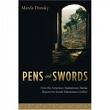|
Reviewed by Donald G. Ellis, Ph.D., Professor of Communication, University of Hartford While there are numerous books analyzing reporting about the Israeli-Palestinian conflict, the hard reality is that many of these books lack in scholarship and objectivity. One of the latest entries in the field, Pens and Swords: How the American Mainstream Media Report the Israeli-Palestinian Conflict, unfortunately does little to change this trend. In Pens and Swords, Marda Dunsky, a former Arab affairs reporter for theJerusalem Post, offers a critical account of what she terms “mainstream media” reporting on the conflict. The book is as much political perspective and interpretive account as it is analytical description of journalist practices. The key thesis is that mainstream media is in the grip of corporate America, and that media reporting on the Israeli-Palestinian conflict is superficial and toes the line of U.S. Middle East policy. The book is compelling enough to hold the reader’s interest; however, in the end both its methodology and findings are flawed. The volume is sprinkled with the language of critical theory (“colonization,” “hegemony,” “apartheid,” “dominant discourse”) without much meaningful engagement of these terms. Although Dunsky believes she has identified bias and distortion because of insufficient context and background for stories, she is really simply calling for advocacy journalism. The suggestions in the final chapter for new ways of reporting the conflict are pointed attempts to “improve” reporting by ratcheting up the criticism of Israel and the U.S. This includes challenges to “the inherent falsity of the postulates of the Washington consensus that address Israel and Palestinians as if they were of equal standing,” giving up the false consciousness of objectivity, ignoring negative audience reactions, and including more oppositional discourse (meaning criticism of Israel and U.S. policy). Pens and Swords is organized into seven chapters that all fall in line to support the author’s claims. Right out the gate, Dunsky sets out to show how coverage reflects U.S. policy and concludes that the mainstream media are essentially a policy mirror. The author then moves into an examination of coverage on the Palestinian refugee story and suggests that the Israeli narrative is naturalized while the Palestinian one is set in opposition, generally treated less seriously, and lacking in historical justification. Subsequent chapters examine how the media reports on Israeli settlers and chastises the major media outlets for accepting official U.S. policy, ignoring issues in international law, and failing to understand cynical political maneuvers; decry the violence of the conflict and stresses that the reporting relies primarily on official Israeli military and government sources; and explain the pressures in the U.S. to report on the war and singles out the “Israel Lobby” as an arm of U.S. policy. This latter point is essentially the controversial Mearsheimer and Walt claim that the U.S. is in the thrall of the pro-Israel lobby and that such a lobby runs American interests and stifles criticism of Israel. Dunsky equates “balanced” and “fair” journalism with reporting more on this influence. But Mearsheimer and Walt have been roundly criticized for their distortion of the basic reality that the pro-Israel lobby is like many other lobbies, and does little more than engage in the democratic process—for which they have every right to participate in—and their success speaks to the confluence of interests between the U.S. and Israel. But Dunsky’s reliance on traditional models of journalism is even more disquieting. She seems to unknowingly cling to the old structure of journalism run on business models and reliant on deadlines and top down reporting. The blogsphere, internet sites, the growing Arab media, and alternative newspapers offer an unprecedented variety of news and opinion on the Israeli-Palestinian conflict and have all created active spaces for discussion, critique, and corrections to traditional news. One blog, for example, revealed how a Reuters’ photographer faked photographs during the Israeli-Hezbollah conflict. Yet Dunsky eschews the effects the “new media” has on coverage of the conflict to focus instead on a call for increased journalistic sensitivity to history and context in the mainstream media—where these sensitivities were never to be found in the first place. The author states that Pens and Swords is not a work of communication theory but of journalistic practice. Still, the volume is highly reliant on theory as a foundation for its criticisms of reporting on the Israeli-Palestinian conflict. There is nothing wrong with such a theoretical foundation, but it is somewhat misleading to represent the book as stripped of ideological preferences. |


 Pens and Swords: How the American Mainstream Media Report the Israeli-Palestinian Conflict
Pens and Swords: How the American Mainstream Media Report the Israeli-Palestinian Conflict